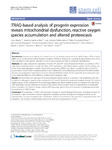Mostrar o rexistro simple do ítem
iTRAQ-Based Analysis of Progerin Expression Reveals Mitochondrial Dysfunction, Reactive Oxygen Species Accumulation and Altered Proteostasis
| dc.contributor.author | Mateos, Jesús | |
| dc.contributor.author | Landeira-Abia, Arancha | |
| dc.contributor.author | Fafián Labora, Juan Antonio | |
| dc.contributor.author | Fernández-Pernas, Pablo | |
| dc.contributor.author | Lesende-Rodríguez, Iván | |
| dc.contributor.author | Fernández-Puente, Patricia | |
| dc.contributor.author | Fernández-Moreno, Mercedes | |
| dc.contributor.author | Delmiro, Aitor | |
| dc.contributor.author | Martín, Miguel A. | |
| dc.contributor.author | Blanco García, Francisco J | |
| dc.contributor.author | Arufe, M.C. | |
| dc.date.accessioned | 2017-03-13T12:31:44Z | |
| dc.date.available | 2017-03-13T12:31:44Z | |
| dc.date.issued | 2015-06-12 | |
| dc.identifier.citation | Mateos J, Landeira-Abia A, Fafián-Labora JA, et al. iTRAQ-based analysis of progerin expression reveals mitochondrial dysfunction, reactive oxygen species accumulation and altered proteostasis. Stem Cell Res Ther [Internet]. 2015 Jun 12; 6:119 | es_ES |
| dc.identifier.issn | 1757-6512 | |
| dc.identifier.uri | http://hdl.handle.net/2183/18241 | |
| dc.description.abstract | [Abstract] Introduction. Nuclear accumulation of a mutant form of the nuclear protein Lamin-A, called Progerin (PG) or Lamin AΔ50, occurs in Hutchinson-Gilford Progeria Syndrome (HGPS) or Progeria, an accelerated aging disease. One of the main symptoms of this genetic disorder is a loss of sub-cutaneous fat due to a dramatic lipodystrophy. Methods. We stably induced the expression of human PG and GFP -Green Fluorescent Protein- as control in 3T3L1 cells using a lentiviral system to study the effect of PG expression in the differentiation capacity of this cell line, one of the most used adipogenic models. Quantitative proteomics (iTRAQ) was done to study the effect of the PG accumulation. Several of the modulated proteins were validated by immunoblotting and real-time PCR. Mitochondrial function was analyzed by measurement of a) the mitochondrial basal activity, b) the superoxide anion production and c) the individual efficiency of the different complex of the respiratory chain. Results. We found that over-expression PG by lentiviral gene delivery leads to a decrease in the proliferation rate and to defects in adipogenic capacity when compared to the control. Quantitative proteomics analysis showed 181 proteins significantly (p < 0.05) modulated in PG-expressing preadipocytes. Mitochondrial function is impaired in PG-expressing cells. Specifically, we have detected an increase in the activity of the complex I and an overproduction of Superoxide anion. Incubation with Reactive Oxygen Species (ROS) scavenger agents drives to a decrease in autophagic proteolysis as revealed by LC3-II/LC3-I ratio. Conclusion. PG expression in 3T3L1 cells promotes changes in several Biological Processes, including structure of cytoskeleton, lipid metabolism, calcium regulation, translation, protein folding and energy generation by the mitochondria. Our data strengthen the contribution of ROS accumulation to the premature aging phenotype and establish a link between mitochondrial dysfunction and loss of proteostasis in HGPS. | es_ES |
| dc.description.sponsorship | Xunta de Galicia; PS07/86 | es_ES |
| dc.description.sponsorship | Instituto de Salud Carlos III; PI11/02799 | es_ES |
| dc.language.iso | eng | es_ES |
| dc.publisher | BioMed Central | es_ES |
| dc.relation.uri | http://dx.doi.org/10.1186/s13287-015-0110-5 | es_ES |
| dc.rights | Atribución 3.0 España | es_ES |
| dc.rights.uri | http://creativecommons.org/licenses/by/3.0/es/ | * |
| dc.title | iTRAQ-Based Analysis of Progerin Expression Reveals Mitochondrial Dysfunction, Reactive Oxygen Species Accumulation and Altered Proteostasis | es_ES |
| dc.type | info:eu-repo/semantics/article | es_ES |
| dc.rights.access | info:eu-repo/semantics/openAccess | es_ES |
| UDC.journalTitle | Stem Cell Research & Therapy | es_ES |
| UDC.volume | 6 | es_ES |
| UDC.issue | 119 | es_ES |
Ficheiros no ítem
Este ítem aparece na(s) seguinte(s) colección(s)
-
GI-TCMR - Artigos [129]
-
INIBIC-TCMR - Artigos [102]
-
INIBIC- REUMA - Artigos [184]






